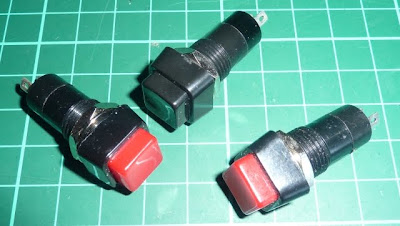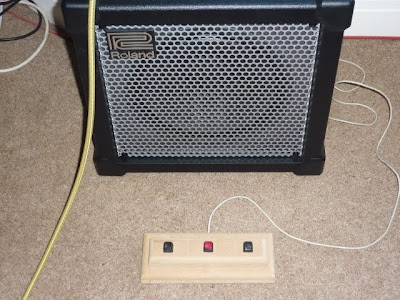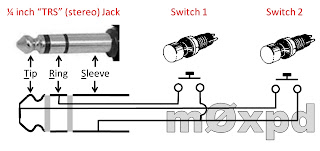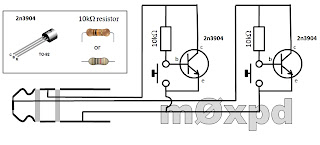I came home from yesterday's
G-QRP Mini Convention at Rishworth with (
amongst other things) some pushbutton switches from
Bowood...
intending to make a footswitch for my new
Roland Cube 40XL guitar amplifier. The project was not quite as trivial as expected and other Cube owners may be interested to hear my findings. But first, a little background...
2012 has been for me thus far what Liz might call
annus horribilis. Illness has robbed me of some of the energy and enthusiasm for leisure projects and work has been even more of a distraction than usual. Even the virtual organ project (
Blogs Passim) has taken a back seat - it is upstairs and it requires that you sit up straight on the uncomfortable, hard bench - hardly the thing when you're not feeling 100%. I did, however, remember that there is one thing that a couch potato can do instead of watching (
or even whilst watching) the idiot's lantern - play guitar!
I treated myself to a nice new guitar in celebration of this re-discovered pastime - a Peerless
New York.
Then thoughts turned to amplifiers. I already have more than my fair share of guitars and amplifiers, but wanted something that included some of the interesting developments of the past few decades (
on-board effects, "modelling" etc). I looked at Fender Super Champs, Line 6 Spiders and the Roland Cube 40XL. I settled on the latter, not least because I could make a simple footswitch to control the many features (rather than pay the manufacturer for one).
So, yesterday I started to knock up a trial footswitch, taking the chance to experiment with an idea for an "enclosure" made of scrap MDF. The piece of scrap that first came to hand was about right for three switches, so that's what I made...
Here's the circuit I used...
(I hope regular readers of this irregular blog will excuse the naive schematics in this post - this material might be of interest to other readers for whom electronics is not the vernacular).
The footswitch worked perfectly in controlling the Effects and Reverb. It also worked perfectly in switching between channels and selecting the alternative "Solo" settings. However, it refused to do anything in controlling the Delay / Looper functions - a particular disappointment as this was the feature I most urgently needed foot control for!
A quick sniff around the net led me to fellow radio amateur Steve, GW1XVC's excellent page on
QRZ.com. Steve has also homebrewed a footswitch for the Cube 40XL and his switch works, as he proves in a video on
YouTube. His
QRZ page included the magic phrase "normally closed", describing the switches he used in his successful footswitch. Mine from Bowood (
like all the other momentary action single pole switches in my junk boxes) are "normally open".
I tried "simulating" a normally closed switch (by holding down both switches and momentarily opening one of them) and - hey presto - the looper functions worked under control of my switches. So - I think I need to make an important announcement...
Owners of Roland's Excellent Cube XL amplifiers who, like me, are too cheap to buy expensive commercial footswitches, can use normally open switches for FX/Reverb and Channel/Solo functions BUT MUST USE NORMALLY CLOSED (/"PUSH TO BREAK") SWITCHES FOR THE DELAY/LOOPER functions.
So - having got that off my chest, what do I do with the apparently useless normally open switches?
I measured the electrical behaviour at the footswitch sockets - open circuit, the control inputs sit at about +3.5V relative to the reference voltage on the sleeves of all the sockets (the footswitch inputs are on 1/4 inch Tip, Ring, Sleeve ('TRS') jack sockets - more commonly known as 'stereo' jacks). When shorted to the sleeve, a current of 450microAmps flows.
I could easily see how to control the looper with the required "normally closed" behaviour if I had some power available, but I didn't want to add a battery to complicate the footswitch - so I came up with a little twist to change the switching behaviour so as to emulate the "normally closed" function using a 2n3904 and a 10k resistor...
For those who don't know, both 2n3904 transistors and 10k resistors are widely available for less money than the switches.
The modified footswitch works perfectly. I just made the change on the two switches used for the Delay/Looper functions - the other switch on my prototype controls the Effects in "normally open" mode.
It works perfectly
for me but now for the caveats:
- It hasn't been tested on another Cube 40XL, so I can't guarantee it will work perfectly for you and...
- It might not like the EMC-hostile conditions of live stage applications (but I'm sure that any issues could be resolved with a single additional capacitor for each transistor) and...
- My footswitch wasn't designed to survive the violent attentions of thrash metal players in Jack Boots. Steve, GW1XVC's rugged construction is more equal to that task!
Now I'm off to play some guitar
...-.- de m0xpd













